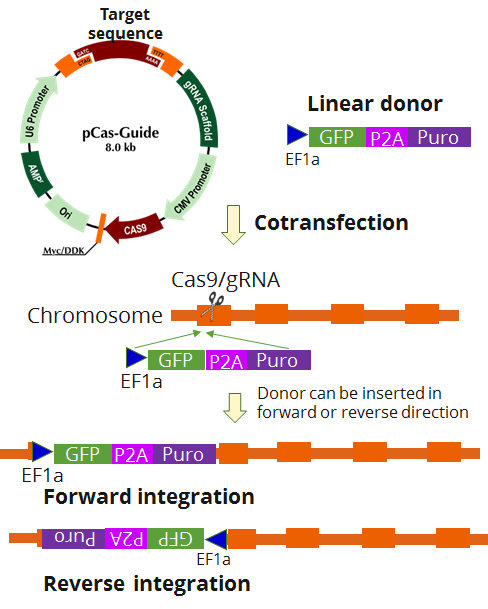Bag6 Mouse Gene Knockout Kit (CRISPR)
CAT#: KN501960
Bag6 - KN2.0, Mouse gene knockout kit via CRISPR, non-homology mediated.
KN2.0 knockout kit validation
USD 1,657.00
2 Weeks*
Specifications
| Product Data | |
| Format | 2 gRNA vectors, 1 linear donor |
| Donor DNA | EF1a-GFP-P2A-Puro |
| Symbol | Bag6 |
| Locus ID | 224727 |
| Components |
KN501960G1, Bag6 gRNA vector 1 in pCas-Guide CRISPR vector KN501960G2, Bag6 gRNA vector 2 in pCas-Guide CRISPR vector KN501960D, Linear donor DNA containing LoxP-EF1A-tGFP-P2A-Puro-LoxP: The sequence below is cassette sequence only. The linear donor DNA also contains proprietary target sequence. LoxP-EF1A-tGFP-P2A-Puro-LoxP (2739 bp) ATAACTTCGT ATAATGTATG CTATACGAAG TTATCGTGAG GCTCCGGTGC CCGTCAGTGG GCAGAGCGCA CATCGCCCAC AGTCCCCGAG AAGTTGGGGG GAGGGGTCGG CAATTGAACC GGTGCCTAGA GAAGGTGGCG CGGGGTAAAC TGGGAAAGTG ATGTCGTGTA CTGGCTCCGC CTTTTTCCCG AGGGTGGGGG AGAACCGTAT ATAAGTGCAG TAGTCGCCGT GAACGTTCTT TTTCGCAACG GGTTTGCCGC CAGAACACAG GTAAGTGCCG TGTGTGGTTC CCGCGGGCCT GGCCTCTTTA CGGGTTATGG CCCTTGCGTG CCTTGAATTA CTTCCACCTG GCTGCAGTAC GTGATTCTTG ATCCCGAGCT TCGGGTTGGA AGTGGGTGGG AGAGTTCGAG GCCTTGCGCT TAAGGAGCCC CTTCGCCTCG TGCTTGAGTT GAGGCCTGGC CTGGGCGCTG GGGCCGCCGC GTGCGAATCT GGTGGCACCT TCGCGCCTGT CTCGCTGCTT TCGATAAGTC TCTAGCCATT TAAAATTTTT GATGACCTGC TGCGACGCTT TTTTTCTGGC AAGATAGTCT TGTAAATGCG GGCCAAGATC TGCACACTGG TATTTCGGTT TTTGGGGCCG CGGGCGGCGA CGGGGCCCGT GCGTCCCAGC GCACATGTTC GGCGAGGCGG GGCCTGCGAG CGCGGCCACC GAGAATCGGA CGGGGGTAGT CTCAAGCTGG CCGGCCTGCT CTGGTGCCTG GCCTCGCGCC GCCGTGTATC GCCCCGCCCT GGGCGGCAAG GCTGGCCCGG TCGGCACCAG TTGCGTGAGC GGAAAGATGG CCGCTTCCCG GCCCTGCTGC AGGGAGCTCA AAATGGAGGA CGCGGCGCTC GGGAGAGCGG GCGGGTGAGT CACCCACACA AAGGAAAAGG GCCTTTCCGT CCTCAGCCGT CGCTTCATGT GACTCCACGG AGTACCGGGC GCCGTCCAGG CACCTCGATT AGTTCTCGAG CTTTTGGAGT ACGTCGTCTT TAGGTTGGGG GGAGGGGTTT TATGCGATGG AGTTTCCCCA CACTGAGTGG GTGGAGACTG AAGTTAGGCC AGCTTGGCAC TTGATGTAAT TCTCCTTGGA ATTTGCCCTT TTTGAGTTTG GATCTTGGTT CATTCTCAAG CCTCAGACAG TGGTTCAAAG TTTTTTTCTT CCATTTCAGG TGTCGTGAAT GGAGAGCGAC GAGAGCGGCC TGCCCGCCAT GGAGATCGAG TGCCGCATCA CCGGCACCCT GAACGGCGTG GAGTTCGAGC TGGTGGGCGG CGGAGAGGGC ACCCCCGAGC AGGGCCGCAT GACCAACAAG ATGAAGAGCA CCAAAGGCGC CCTGACCTTC AGCCCCTACC TGCTGAGCCA CGTGATGGGC TACGGCTTCT ACCACTTCGG CACCTACCCC AGCGGCTACG AGAACCCCTT CCTGCACGCC ATCAACAACG GCGGCTACAC CAACACCCGC ATCGAGAAGT ACGAGGACGG CGGCGTGCTG CACGTGAGCT TCAGCTACCG CTACGAGGCC GGCCGCGTGA TCGGCGACTT CAAGGTGATG GGCACCGGCT TCCCCGAGGA CAGCGTGATC TTCACCGACA AGATCATCCG CAGCAACGCC ACCGTGGAGC ACCTGCACCC CATGGGCGAT AACGATCTGG ATGGCAGCTT CACCCGCACC TTCAGCCTGC GCGACGGCGG CTACTACAGC TCCGTGGTGG ACAGCCACAT GCACTTCAAG AGCGCCATCC ACCCCAGCAT CCTGCAGAAC GGGGGCCCCA TGTTCGCCTT CCGCCGCGTG GAGGAGGATC ACAGCAACAC CGAGCTGGGC ATCGTGGAGT ACCAGCACGC CTTCAAGACC CCGGATGCAG ATGCCGGTGA AGAAAGAGGA AGCGGAGCTA CTAACTTCAG CCTGCTGAAG CAGGCTGGAG ACGTGGAGGA GAACCCTGGA CCTATGACCG AGTACAAGCC CACGGTGCGC CTCGCCACCC GCGACGACGT CCCCAGGGCC GTACGCACCC TCGCCGCCGC GTTCGCCGAC TACCCCGCCA CGCGCCACAC CGTCGATCCG GACCGCCACA TCGAGCGGGT CACCGAGCTG CAAGAACTCT TCCTCACGCG CGTCGGGCTC GACATCGGCA AGGTGTGGGT CGCGGACGAC GGCGCCGCGG TGGCGGTCTG GACCACGCCG GAGAGCGTCG AAGCGGGGGC GGTGTTCGCC GAGATCGGCC CGCGCATGGC CGAGTTGAGC GGTTCCCGGC TGGCCGCGCA GCAACAGATG GAAGGCCTCC TGGCGCCGCA CCGGCCCAAG GAGCCCGCGT GGTTCCTGGC CACCGTCGGC GTCTCGCCCG ACCACCAGGG CAAGGGTCTG GGCAGCGCCG TCGTGCTCCC CGGAGTGGAG GCGGCCGAGC GCGCCGGGGT GCCCGCCTTC CTGGAGACCT CCGCGCCCCG CAACCTCCCC TTCTACGAGC GGCTCGGCTT CACCGTCACC GCCGACGTCG AGGTGCCCGA AGGACCGCGC ACCTGGTGCA TGACCCGCAA GCCCGGTGCC TGAAACTTGT TTATTGCAGC TTATAATGGT TACAAATAAA GCAATAGCAT CACAAATTTC ACAAATAAAG CATTTTTTTC ACTGCATTCT AGTTGTGGTT TGTCCAAACT CATCAATGTA TCTTAATAAC TTCGTATAAT GTATGCTATA CGAAGTTAT
|
| Disclaimer | These products are manufactured and supplied by OriGene under license from ERS. The kit is designed based on the best knowledge of CRISPR technology. The system has been functionally validated for knocking-in the cassette downstream the native promoter. The efficiency of the knock-out varies due to the nature of the biology and the complexity of the experimental process. |
| Reference Data | |
| RefSeq | NM_001252468, NM_001252469, NM_057171 |
| UniProt ID | Q9Z1R2 |
| Synonyms | 2410045D21Rik; AA408914; BAG-6; Bat3; D17H6S52E; G3; Scythe |
| Summary | ATP-independent molecular chaperone preventing the aggregation of misfolded and hydrophobic patches-containing proteins (PubMed:18056262, PubMed:18678708, PubMed:20713601). Functions as part of a cytosolic protein quality control complex, the BAG6/BAT3 complex, which maintains these client proteins in a soluble state and participates to their proper delivery to the endoplasmic reticulum or alternatively can promote their sorting to the proteasome where they undergo degradation (PubMed:20713601). The BAG6/BAT3 complex is involved in the post-translational delivery of tail-anchored/type II transmembrane proteins to the endoplasmic reticulum membrane. Recruited to ribosomes, it interacts with the transmembrane region of newly synthesized tail-anchored proteins and together with SGTA and ASNA1 mediates their delivery to the endoplasmic reticulum. Client proteins that cannot be properly delivered to the endoplasmic reticulum are ubiquitinated by RNF126, an E3 ubiquitin-protein ligase associated with BAG6 and are sorted to the proteasome. SGTA which prevents the recruitment of RNF126 to BAG6 may negatively regulate the ubiquitination and the proteasomal degradation of client proteins. Similarly, the BAG6/BAT3 complex also functions as a sorting platform for proteins of the secretory pathway that are mislocalized to the cytosol either delivering them to the proteasome for degradation or to the endoplasmic reticulum. The BAG6/BAT3 complex also plays a role in the endoplasmic reticulum-associated degradation (ERAD), a quality control mechanism that eliminates unwanted proteins of the endoplasmic reticulum through their retrotranslocation to the cytosol and their targeting to the proteasome. It maintains these retrotranslocated proteins in an unfolded yet soluble state condition in the cytosol to ensure their proper delivery to the proteasome (By similarity). BAG6 is also required for selective ubiquitin-mediated degradation of defective nascent chain polypeptides by the proteasome. In this context, it may participate to the production of antigenic peptides and play a role in antigen presentation in immune response (PubMed:20713601). BAG6 is also involved in endoplasmic reticulum stress-induced pre-emptive quality control, a mechanism that selectively attenuates the translocation of newly synthesized proteins into the endoplasmic reticulum and reroutes them to the cytosol for proteasomal degradation. BAG6 may ensure the proper degradation of these proteins and thereby protects the endoplasmic reticulum from protein overload upon stress (By similarity). By inhibiting the polyubiquitination and subsequent proteasomal degradation of HSPA2 it may also play a role in the assembly of the synaptonemal complex during spermatogenesis (PubMed:18678708). Also positively regulates apoptosis by interacting with and stabilizing the proapoptotic factor AIFM1 (PubMed:18056262). By controlling the steady-state expression of the IGF1R receptor, indirectly regulates the insulin-like growth factor receptor signaling pathway (By similarity).[UniProtKB/Swiss-Prot Function] |
Documents
| Product Manuals |
| FAQs |
| SDS |
Resources
Other Versions
| SKU | Description | Size | Price |
|---|---|---|---|
| GA213718 | Bag6 CRISPRa kit - CRISPR gene activation of mouse BCL2-associated athanogene 6 |
USD 1,657.00 |
{0} Product Review(s)
Be the first one to submit a review






























































































































































































































































 Germany
Germany
 Japan
Japan
 United Kingdom
United Kingdom
 China
China

